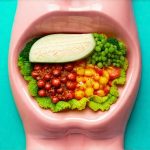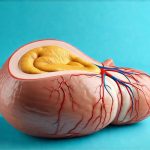The sensation of being repulsed by certain food textures is surprisingly common, yet often dismissed as mere pickiness. However, for many individuals, this aversion goes beyond simple preference; it’s a deeply unsettling experience that can significantly impact their diet and quality of life. This isn’t always about disliking the taste – sometimes, the very idea of a particular texture triggers feelings ranging from mild discomfort to intense nausea and even panic. Understanding why this happens requires looking beyond psychological factors and delving into the complex interplay between our gut, our brains, and the subtle receptors that constantly monitor what we ingest.
The root of these textural aversions often lies in how our sensory systems process information about food. We experience food through multiple channels – sight, smell, taste, and touch (texture). These signals are integrated in the brain to create a comprehensive perception that dictates whether something is appealing or repulsive. In individuals with strong textural aversion, the tactile component—how the food feels in the mouth—is disproportionately amplified, often overshadowing other sensory inputs. This can be due to heightened sensitivity, differences in neural processing, or even underlying conditions impacting sensory integration. What many people see as a harmless texture – slimy, mushy, grainy, stringy – becomes an overwhelming and unpleasant sensation, leading to avoidance behaviors and dietary restrictions. Understanding the connection between gut bacteria and these anxieties can be helpful – the connection.
The Role of Gut Receptors & Sensory Processing
Our digestive system isn’t just about breaking down food; it’s also a remarkably sophisticated sensory organ. Throughout the gastrointestinal tract are specialized receptors that detect various aspects of ingested substances – chemical composition (taste), mechanical properties (texture), and even potential threats. These receptors send signals directly to the brain, influencing our perception of food and triggering physiological responses like salivation, gut motility, and hormone release. Certain receptors, like mechanoreceptors in the mouth and esophagus, are particularly sensitive to texture. They detect pressure, stretch, and vibration, providing crucial information about the physical characteristics of food as we chew and swallow. It’s thought that an overstimulation or misinterpretation of these signals can contribute to textural aversion.
Furthermore, there’s growing evidence linking gut health to sensory processing. A compromised gut microbiome—an imbalance in the community of microorganisms living in our intestines—can affect neural pathways involved in taste and texture perception. Inflammation within the gut also impacts brain function, potentially altering how we perceive sensory information. In individuals with heightened textural aversion, it’s plausible that imbalances in the gut imbalance or chronic low-grade inflammation contribute to increased sensitivity or altered processing of tactile stimuli related to food textures. This creates a feedback loop where unpleasant sensations lead to avoidance, further impacting gut health and exacerbating the problem. The relationship between gut imbalances and sensitivities is worth exploring.
The Vagal Nerve Connection
The vagal nerve is a crucial component of the gut-brain axis – the bidirectional communication network between the digestive system and the brain. It acts as a direct pathway for transmitting sensory information from the gut to the central nervous system. Mechanoreceptors in the gastrointestinal tract send signals via the vagal nerve, providing real-time updates on food texture and triggering appropriate responses. Dysfunction of the vagal nerve or altered vagal tone—the level of activity within the nerve—can disrupt this communication, potentially leading to inaccurate sensory perception and increased sensitivity to textures.
Studies have shown that individuals with anxiety or heightened emotional reactivity often exhibit altered vagal tone, which may contribute to increased sensory awareness and a tendency towards hypervigilance regarding food textures. This means they are more likely to notice and be bothered by subtle textural differences that others might not even register. Additionally, chronic stress can negatively impact vagal nerve function, exacerbating these sensitivities. Restoring healthy vagal tone through techniques like deep breathing exercises, meditation, or mindfulness may offer a potential avenue for managing textural aversion in some individuals. This highlights the importance of addressing issues with leaky gut and anxiety – the link.
Interoception and Body Awareness
Interoception is the sense of the internal state of your body – things like hunger, fullness, heart rate, and gut feelings. It’s how we perceive what’s happening inside our bodies without needing to see or feel externally. Individuals with strong textural aversion often exhibit heightened interoceptive awareness, meaning they are acutely attuned to subtle sensations within their digestive system. This can lead to a more intense experience of textures as they become linked to internal bodily responses – nausea, discomfort, even anxiety.
This increased interoceptive sensitivity isn’t necessarily negative; it can be valuable for understanding and responding to the body’s needs. However, when coupled with heightened sensory processing related to food texture, it can create a cascade of unpleasant sensations that reinforces avoidance behaviors. It’s akin to having an amplified internal alarm system constantly scanning for potential threats in food textures.
The Role of Mirror Neurons & Learned Aversions
Mirror neurons are brain cells that fire both when we perform an action and when we observe someone else performing the same action. They play a key role in empathy, learning through imitation, and understanding others’ experiences. In the context of textural aversion, mirror neurons may contribute to learned aversions based on observations of others’ reactions to food textures. If a child repeatedly witnesses parents or caregivers expressing disgust towards certain foods, they may internalize those feelings and develop similar aversions themselves.
Furthermore, negative experiences with specific textures – choking, vomiting, or simply feeling uncomfortable after eating something – can create strong associative learning. The brain links the texture with the unpleasant experience, triggering aversion responses even in the absence of any actual threat. This is why it’s important to approach food introductions carefully and avoid forcing children to eat foods they dislike, as this can reinforce negative associations.
Beyond Sensory: Emotional & Psychological Factors
While physiological factors play a significant role, emotional and psychological components are inextricably linked to textural aversion. Past trauma, anxiety disorders, or obsessive-compulsive tendencies can all contribute to heightened sensitivity and avoidance behaviors related to food textures. For example, individuals with a history of restrictive eating or disordered eating may develop strong anxieties around food that manifest as textural aversions.
Moreover, the way we learn to associate emotions with specific foods can profoundly impact our preferences. If a particular texture is consistently associated with negative emotional experiences – stress, social pressure, or feelings of inadequacy – it’s likely to become aversive over time. This highlights the importance of addressing underlying psychological factors in conjunction with physiological interventions when managing textural aversion. A holistic approach that considers both the mind and body offers the best chance for long-term success. Understanding how environmental chemicals can affect gut health is also important – the link.
It’s important to note that this is a complex phenomenon, and there’s no one-size-fits-all solution. Identifying the specific triggers, understanding the underlying mechanisms, and addressing both physiological and psychological factors are crucial steps towards managing textural aversion and improving an individual’s relationship with food. The impact of gut health on focus and screen time is also relevant – the link. Moreover, consider the impact of a healthy gut on eye dryness – the link. Finally, understanding how the gut microbiota impacts IBS is critical – the link.


















